|
LEARN MORE
Mori Wins Gold
Mori's 90M Kiln
Kiln Guide
Bizen Guide

Yellin's gallery
sells pieces from
the kilns of Japan's
finest potters
|
|
|
 The following article was first printed in DARUMA magazine, Issue 19, 1998. Since that time, Mori Togaku has continued work on his 90-meter kiln. I visited the sprawling compound last autumn (2002) and pictures of how the kiln is progressing can be seen here. It is truly an amazing undertaking! Please note - among below photos, some are new additions that did not appear in the original DARUMA article. The following article was first printed in DARUMA magazine, Issue 19, 1998. Since that time, Mori Togaku has continued work on his 90-meter kiln. I visited the sprawling compound last autumn (2002) and pictures of how the kiln is progressing can be seen here. It is truly an amazing undertaking! Please note - among below photos, some are new additions that did not appear in the original DARUMA article.
|
|
|
The Kilns & Art of Mori Togaku
Daruma Magazine, Issue 19, 1998
Story for Daruma by R. Yellin
The kilns of Bizen ceramic artist Mori Togaku (b.1937-) are as much a part of his creations as his quintessential Bizen pottery. This soft-spoken ceramic giant, dubbed Bizen's kisai (great genius), has one eye looking back 500 years for kiln inspiration and the other eye fixed on 2008 (see below); in spite of this time travel, he has both feet firmly rooted in the present.
Togaku's deep spiritual searching into the essence of Bizen (he looks like a Zen monk) alone separates him from ordinary potters -- his success and continuing attempts to do the seemingly impossible have put him in a class all by himself.
What has Togaku done that is so remarkable? Quite simply, Togaku has expanded the often-stagnant world of Bizen with his reintroduction of the ogama (large single-chamber tunnel kiln) that first appeared in the Muromachi Period (1392-1568). It was then that large kilns were made in Bizen and those magnificent structures fired Bizen masterpieces, mostly in the Momoyama Period (1568-1615). There were three ogama in Bizen -- the North, South, and West kilns. Guilds were responsible for the production of the stonewares.
They were exclusive and membership was a hereditary privilege. During the mid-Jokyo Era (1664-1688), the North and South kilns had ten members each, and the West kiln nine. In 1849 there was an increase of just fourteen members for all three kilns combined. These great kilns averaged about forty-five meters in length, four meters in width and two meters in height -- an incredible 35,000 pieces were fired each time. Togaku speculates that an even greater kiln of 100 meters existed but it has yet to be proven. Firing was done about once a year with each member being allotted spaces for his pieces. The senior members got the preferred spots: all works were identified by a kiln mark, often etched on the body or base of the piece. For more on kilns, please see our Guidebook.
The Ogama System lasted from the end of the Muromachi Period until near the end of the Edo Period. Since ogama were so wasteful of fuel, a new kiln was built in the Tempo Era (1830-1844) to use less scarce red pine wood. The 16-meter long Tempo or "Convenience Kiln" was built just below the North kiln, thus ending the glory days of Bizen.
Togaku's Dream
That was until Togaku had a dream -- to revive the ogama. He feels it is the only way to create work to rival the beauty of classical Ko-Bizen (Old Bizen), which connoisseurs prize so highly. No manuals remain from the 16th century on how to build an ogama. Appointed an Okayama Intangible Cultural Property in 1996, Togaku struggled for years trying to figure out how to construct one. It was an ascetic undertaking of the most strenuous kind as he was staking his soul.
In 1972 he completed his first ogama in Aioi City, Hyogo Prefecture. The kiln was dug on the side of a mountain and measured fifty meters long; it was a work of art by itself. The kiln took 300 tons of clay to build and Togaku estimates the same weight of red pine to fire. Loading the kiln took thirty days. Firing lasted an incredible 55 days, much longer than the usual one to two weeks using a typical Bizen noborigama (multi-chambered climbing kiln) or an anagama (tunnel kiln). Cooling the kiln took another 30 days. Unloading and cleaning out excessive ash took more time -- in all, the process lasted more than half a year.
What came out of the kiln delighted and amazed the Japanese pottery world -- yet Togaku has always been exceptional.
Togaku was born into the illustrious Mori family, one of Bizen's six old potting families. In 1582 or 1583, the powerful Toyotomi Hideyoshi stayed with a village elder (possibly Ohan Gorozaemon). He was so impressed with the potter's skill and others' at making tea utensils that Hideyoshi declared the area a no-war zone and designated six families as protected o-sakunin (honorable craftsmen).
The six families are the Mori, Kaneshige, Kimura, Ohan, Hayami, and Terami -- it is interesting to note that the first three are still potting families.
Togaku grew up with Bizen in his blood and displayed creative talent at an early age, building his first kiln while still in elementary school. In 1962 he became an independent potter and seven years later he was awarded the prestigious Japan Ceramic Society Award (editors note, he won the even more prestigious JSC Gold Award in 2002; click here for photo tour of that award event). That same year he was part of the now legendary three-man exhibition, along with the late Kamoda Shoji and Ezaki Issei, at Gallery Te. Togaku pieces were bought by the National Museums of Modern Art in Tokyo and Kyoto.
Yet he did not rest on his laurels and continued to search for the exceptional in seemingly ordinary vessels like large jars or kame. Togaku builds them with coils.
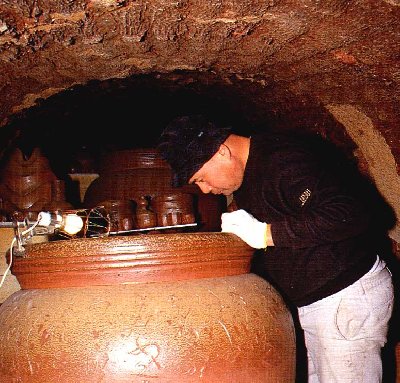
Mori looking inside large kame
A jar takes some 60 days to complete and is 120 centimeters high. He makes may mortars, bowls and other utensils for the kaiseki meals which precede a formal tea ceremony.
His pieces for the kaiseki and tea ceremony include:
- mukozuke (small food dishes)
- tokkuri (sake flasks)
- guinomi (sake cups)
- chawan (tea bowls)
- chaire (caddies for powdered tea)
- mizusashi (fresh water containers).
He also fired slip-painted earthenware in the early 1970s and black faceted vases in the 80s.
Black Vase by Mori Togaku
Teaware Designs
Togaku's traditional and original inspired shapes will not jump out at the viewer with their brilliant colors or fancy designs. Rather, his pieces uphold the aesthetics of Tea, where tasteful, quiet, unostentatious beauty is desired.
To the untrained eye they may appear overly plain with no outward redeeming quality, yet this is exactly the quality that the great Tea masters of the past coveted -- more interested in the "spirit" of the piece than its showiness. Togaku's spirit is as deep and pure as a holy well.
The rugged tabimakura vase (literally "traveling pillow") pictured below has light brown-reddish coloring with flecks of "sesame seed" softly sprinkled over its body. The clay is not the usual ta-zuchi (rice paddy clay) with its high iron content that gives Bizen deep browns and reds, but a lighter yama-zuchi (mountain clay).
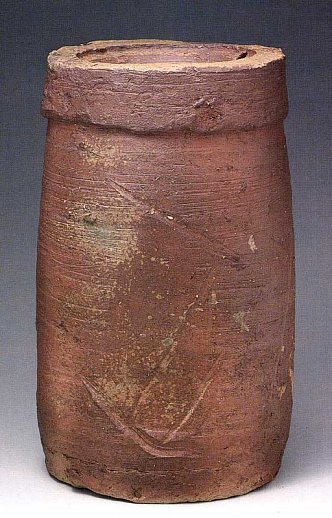
Tabimakura by Mori Togaku
Swift bamboo spatula cuts have been spontaneously etched on the body. As with most ceramics, its subtle and modest beauty will be seen most clearly when a simple flower arrangement is made in it. The vase was not fired in his Aioi kiln; he fired that only once.
It was fired in a 53-meter ogama that he built in Ushimado, Okayama Prefecture, in 1983 and named Samukaze (Cold Wind).
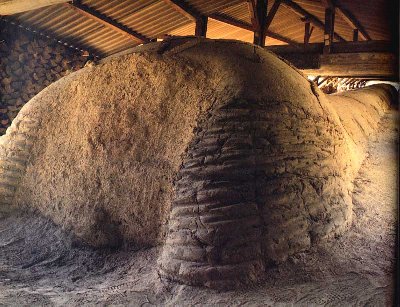
Mori Togaku's 53-meter kiln with front sealed after firing
The previous year, he had built yet another kiln in Ushimado, 20 meters long. He fires the larger kiln only once every four or five years: the first firing in 1985, the second in 1989, and third in 1994. The last is planned for this year. (Editor's note -- the third firing was completed in 2000).
I have visited this kiln a number of times and have never seen another like it -- it is like a dragon sleeping on the side of a mountain which wakes every four years and is fed 300 tons of red pine. Crews work round the clock stoking wood into its mouth, unable ever to gratify
Celebrating 2008
Being the extraordinary man that he is, Togaku has plans for yet another ogama, one that seems beyond the power of any mortal human. For now he is entering into another realm where no other potter working alone has ever trod.
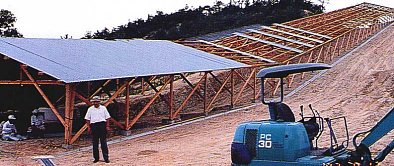
Mori Togaku in front of his 90-meter kiln, now under construction
Already a trench has been carved in a hillside in Ushimado for a massive 90-meter kiln that he plans to fire only once, in 2008. It took 200 two-ton dump trucks to remove the earth needed to make the 1.8-high-by-5.8-meter-wide trench (6 x 19 feet). It will take ten years just to make the pieces to load into the kiln! Togaku will be 72 then and this sure-to-be-amazing firing will be a glorious swansong. Then he will go quietly back to his search for the meaning of being a Bizen potter or perhaps retire and take up residence in the land of the Titans.
LEARN MORE
|